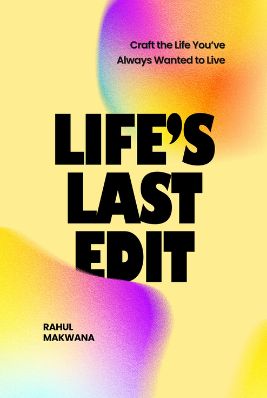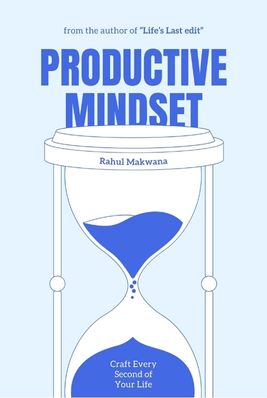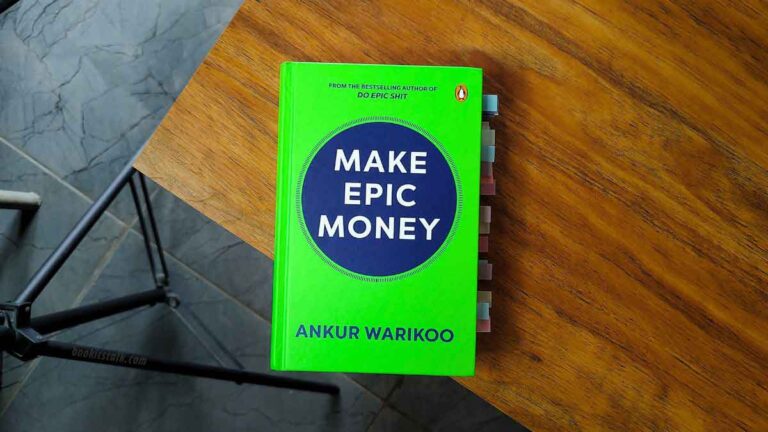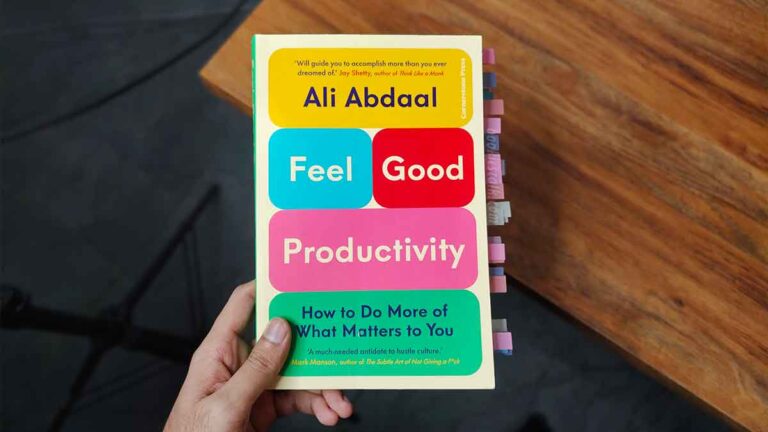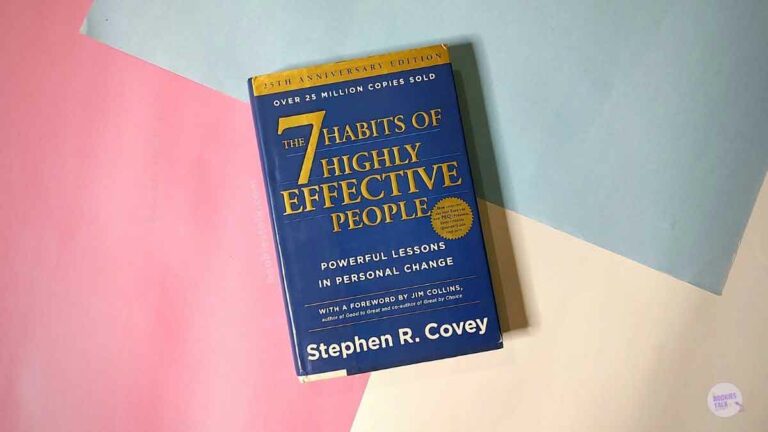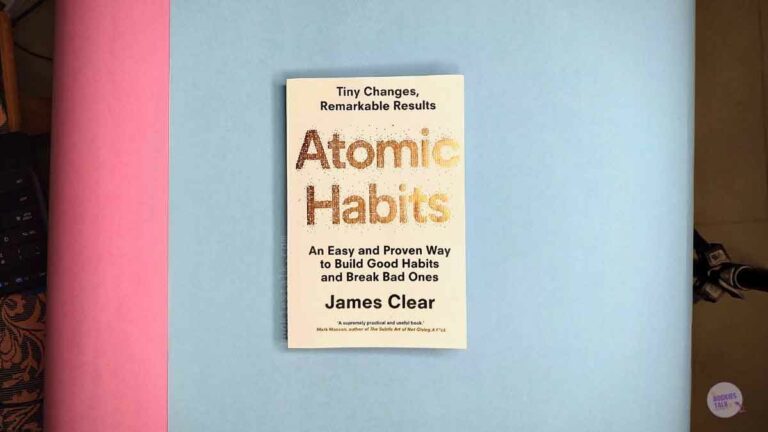Chapter By Chapter Notes From Atomic Habits
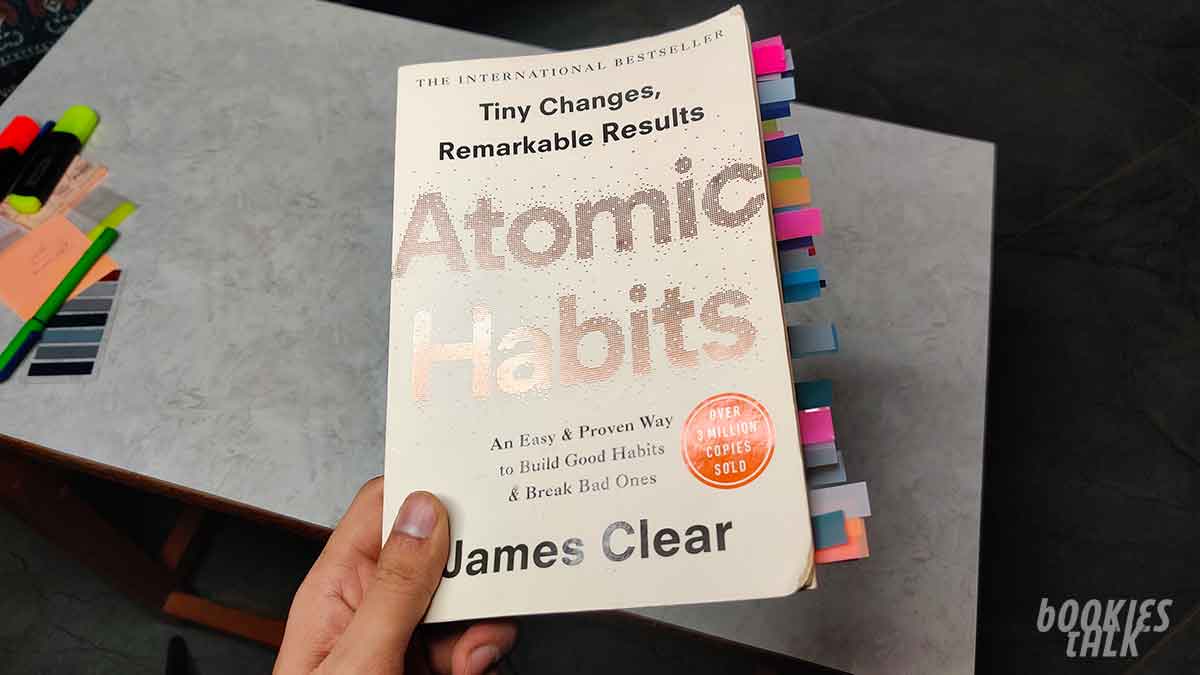
The Atomic Habits by James Clear is divided into 6 parts and has 20 chapters. Now, when I was reading the book, I took lots of notes and this is what I’m about to share with you.
James Clear has taught me a lot about how my brain works and how I can rewire my habits. So I would highly recommend you grab a copy of this book and I’m sure it will do the same for you.
Enter your email address To join the newsletter. I will be with you every Sunday at 9:00 AM (IST). See you on Sundays.
Atomic Habits Notes
It’s always easy to make plans and perform for a few days, but the problems come after a few days. You tend to come back to the same environment as you were before.
If you repeat the same things again and again then how can you expect the new results?
So change your Habits but how? This is what I’m about to share with you.
I have arranged all of my bookmarks chapter by chapter for your convenience. You can come back here any time and re-read all the notes.
Happy Reading.
Chapter No. 1: The Surprising Power of the Atomic Habits

- Improving by 1 percent isn’t particularly notable- sometimes it isn’t even noticeable- but it can be far more meaningful, especially in the long run.
- Habits are the compound interest of self-improvement.
- A slight change in your daily habits can guide your life to a very different destination.
- Your outcomes are a lagging measure of your habits. Your net worth is a lagging measure of your financial habits. Your weight is a lagging measure of your eating habits. Your knowledge is a lagging measure of your learning habits. Your clutter is a lagging measure of your cleaning habits. You get what you repeat.
- Good habits make time your ally. Bad habits make time your enemy.
- You think, “I’ve been running every day for a month, so why can’t I see any change in my body?” Once this kind of thinking takes over, it’s easy to let good habits fall by the wayside
- In the words of three-time Super Bowl winner Bill Walsh, “The score takes care of itself.” The same is true for other areas of life. If you want better results, then forget about setting goals. Focus on your system instead.
- When you fall in love with the process rather than the product, you don’t have to wait to give yourself permission to be happy
- If you’re having trouble changing your habits, the problem isn’t you The problem is your system. Bad habits repeat themselves again and again not because you don’t want to change, but because you have the wrong system for change
- The implicit assumption behind any goal is this: “Once I reach my goal, then I’ll be happy.” The problem with a goals-first mentality is that you’re continually putting happiness off until the next milestone.
Chapter No. 2: How Your Habits Shape Your Identity (and Vice Versa)

- Changing our habits is challenging for two reasons: (1) we try to change the wrong thing and (2) we try to change our habits in the wrong way.
- Outcomes are about what you get. Processes are about what you do.
- Most people don’t even consider identity change when they set out to improve. They just think, “I want to be skinny (outcome) and if I stick to this diet, then I’ll be skinny (process).” They set goals and determine the actions they should take to achieve those goals without considering the beliefs that drive their actions. They never shift the way they look at themselves, and they don’t realize that their old identity can sabotage their new plans for change.
- The more pride you have in a particular aspect of your identity, the more motivated you will be to maintain the habits associated with it.
- Improvements are only temporary until they become part of who you are.
- (1) The goal is not to read a book, the goal is to become a reader.
- (2) The goal is not to run a marathon, the goal is to become a runner.
- (3) The goal is not to learn an instrument, the goal is to become a musician.
- Progress requires unlearning. Becoming the best version of yourself requires you to continuously edit your beliefs, and to upgrade and expand your identity.
- New identities require new evidence. If you keep casting the same votes you’ve always cast, you’re going to get the same results you’ve always had. If nothing changes, nothing is going to change. It is a simple two-step process:
- (1) Decide the type of person you want to be.
- (2) Prove it to yourself with small wins.
- Putting this all together, you can see that habits are the path to changing your identity. The most practical way to change who you are is to change what you do.
- (1) Each time you write a page, you are a writer.
- (2) Each time you practice the violin, you are a musician.
- (3) Each time you start a workout, you are an athlete.
- (4) Each time you encourage your employees, you are a leader.
- The true question is: “Are you becoming the type of person you want to become?” The first step is not what or how, but who. You need to know who you want to be.
- You have a choice in every movement.
Chapter No. 3: How to Build Better Habits in 4 Simple Steps
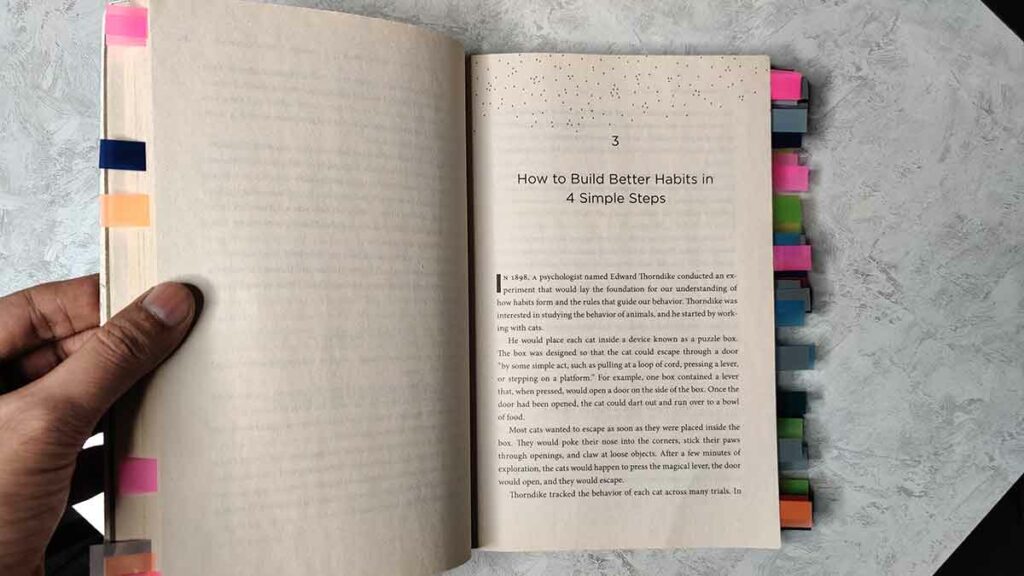
- From his studies, Thorndike described the learning process by stating, “behaviors followed by satisfying consequences tend to be repeated and those that produce unpleasant consequences are less likely to be repeated.”
- When a similar situation arises in the future, you know exactly what to look for. There is no longer a need to analyze every angle of a situation. Your brain skips the process of trial and error and creates a mental rule: if this, then that.
- If you’re always being forced to make decisions about simple tasks should I work out, where do I go to write, when do I pay the bills-then you have less time for freedom? It’s only by making the fundamentals of life easier that you can create the mental space needed for free thinking and creativity.
- If a particular action requires more physical or mental effort than you are willing to expend, then you won’t do it.
- The cue is about noticing the reward. The craving is about wanting the reward. The response is about obtaining the reward. We chase rewards because they serve two purposes:
- (1) they satisfy us and
- (2) they teach us.
- Your brain is a reward detector.
- All behavior is driven by the desire to solve a problem.
- Whenever you want to change your behavior, you can simply ask yourself
- (1) How can I make it obvious?
- (2) How can I make it attractive?
- (3) How can I make it easy?
- (4) How can I make it satisfying?
Chapter No. 4: The Man Who Didn’t Look Right
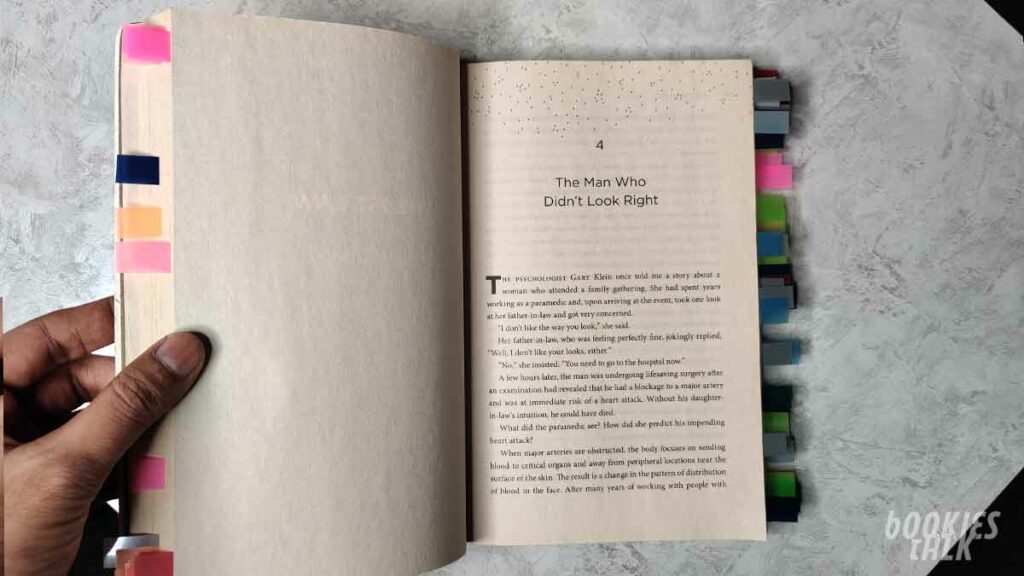
- Pointing-and-Calling is so effective because it raises the level of awareness from a nonconscious habit to a more conscious level. Because the train operators must use their eyes, hands, mouth, and ears, they are more likely to notice problems before something goes wrong.
- One of our greatest challenges in changing habits is maintaining awareness of what we are actually doing.
- Generally speaking, good habits will have net positive outcomes. Bad habits have net negative outcomes. Smoking a cigarette may reduce stress right now (that’s how it’s serving you), but it’s not a healthy long-term behavior.
- If you eat a chocolate bar every morning, acknowledge it, almost as if you were watching someone else. Oh, how interesting that they would do such a thing. If you binge-eat, simply notice that you are eating more calories than you should. If you waste time online, notice that you are spending your life in a way that you do not want to.
Chapter No. 5: The Best Way To Start a New Habit
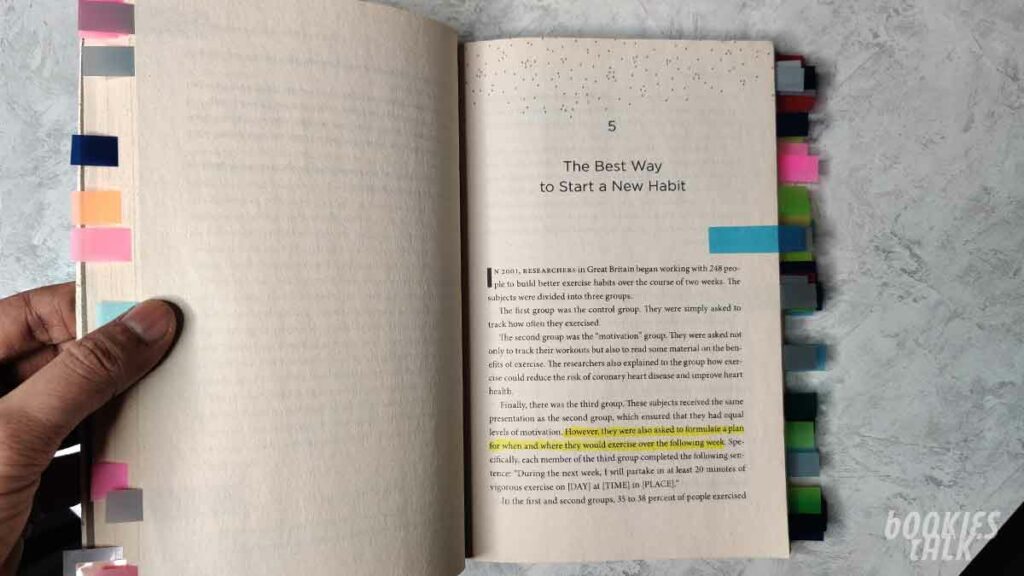
- Hundreds of studies have shown that implementation intentions are effective for sticking to our goals, whether it’s writing down the exact time and date of when you will get a flu shot or recording the time of your colonoscopy appointment. They increase the odds that people will stick with habits like recycling, studying, going to sleep early, and stopping smoking.
- Once an implementation intention has been set, you don’t have to wait for inspiration to strike. Do I write a chapter today or not? Do I meditate this morning or at lunch? When the moment of action occurs, there is no need to make a decision. Simply follow your predetermined plan. The simple way to apply this strategy to your habits is to fill out this sentence: I will [BEHAVIOR] at [TIME] in [LOCATION].
- (1) Meditation. I will meditate for one minute at 7 a.m. in my kitchen.
- (2) Studying. I will study Spanish for twenty minutes at 6 p.m. in my bedroom.
- (3) Exercise. I will exercise for one hour at 5 p.m. in my local gym.
- (4) Marriage. I will make my partner a cup of tea at 8 a.m. in the kitchen.
- Give your habits a time and a space to live in the world. The goal is to make the time and location so obvious that, with enough repetition, you get an urge to do the right thing at the right time, even if you can’t say why.
- Diderot’s behavior is not uncommon. In fact, the tendency for one purchase to lead to another one has a name: the Diderot Effect. The Diderot Effect states that obtaining a new possession often creates a spiral of consumption that leads to additional purchases.
- For example, you may already have a morning routine that looks like this: Wake up > Make my bed > Take a shower. Let’s say you want to develop the habit of reading more each night. You can expand your habit stack and try something like: Wake up > Make my bed> Place a book on my pillow > Take a shower. Now, when you climb into bed each night, a book will be sitting there waiting for you to enjoy.
- The 1st Law of Behavior Change is to make it obvious.
Chapter No. 6: Motivation Is Overrated; Environment Often Matters More
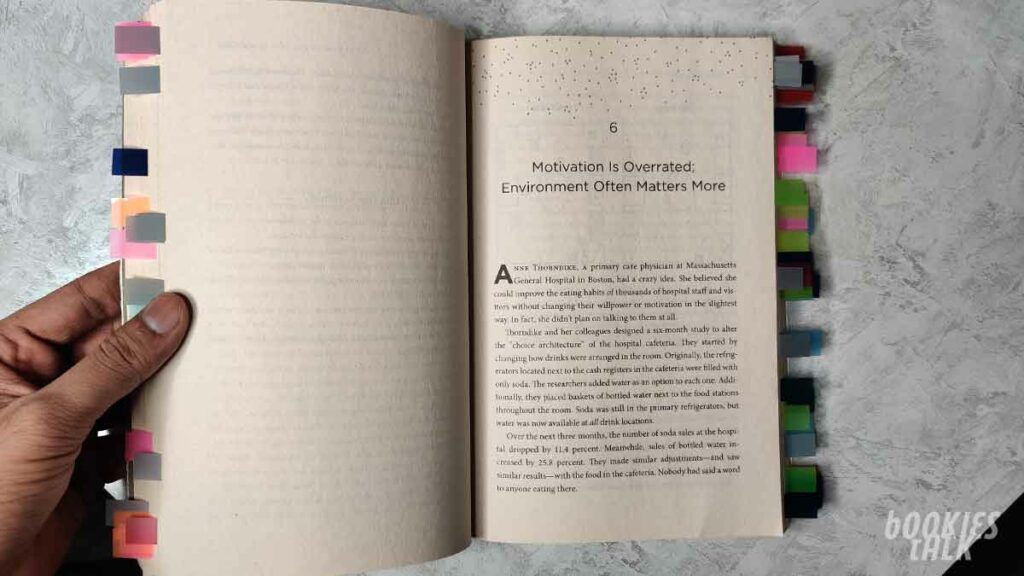
- People often choose products not because of what they are, but because of where they are
- It didn’t take long for Lewin’s Equation to be tested in business. In 1952, the economist Hawkins Stern described a phenomenon he called Suggestion Impulse Buying, which “is triggered when a shopper sees a product for the first time and visualizes a need for it.” In other words, customers will occasionally buy products not because they want them but because of how they are presented to them.+
- It’s easy not to practice the guitar when it’s tucked away in the closet. It’s easy not to read a book when the bookshelf is in the corner of the guest room. It’s easy not to take your vitamins when they are out of sight in the pantry. When the cues that spark a habit are subtle or hidden, they are easy to ignore
- Here are a few ways you can redesign your environment and make the cues for your preferred habits more obvious:
- (1) If you want to remember to take your medication each night, put your pill bottle directly next to the faucet on the bathroom counter.
- (2) If you want to practice guitar more frequently, place your guitar stand in the middle of the living room.
- (3) If you want to remember to send more thank-you notes, keep a stack of stationery on your desk.
- (4) If you want to drink more water, fill up a few water bottles each morning and place them in common locations around the house.
- For example, many people drink more in social situations than they would ever drink alone. The trigger is rarely a single cue, but rather the whole situation: watching your friends order drinks, hearing the music at the bar, seeing the beers on tap.
- In one study, scientists instructed insomniacs to get into bed only when they were tired. If they couldn’t fall asleep, they were told to sit in a different room until they became sleepy. Over time, subjects began to associate the context of their bed with the action of sleeping, and it became easier to quickly fall asleep when they climbed in bed. Their brains learned that sleeping- not browsing on their phones, not watch- ing television, not staring at the clock- was the only action that happened in that room.
- Focus comes automatically when you are sitting at your work desk. Relaxation is easier when you are in a space designed for that purpose. Sleep comes quickly when it is the only thing that happens in your bedroom. If you want behaviors that are stable and predictable, you need an environment that is stable and predictable.
Chapter No. 7: The Secret to Self-Control
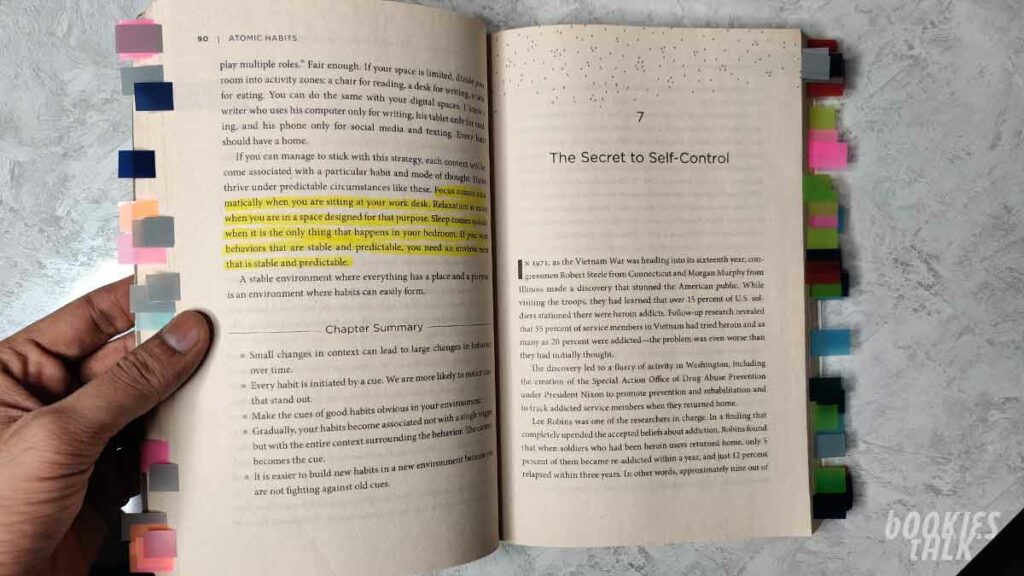
- In Vietnam, soldiers spent all day surrounded by cues triggering heroin use: it was easy to access, they were engulfed by the constant stress of war, they built friendships with fellow soldiers who were also heroin users, and they were thousands of miles from home. Once a soldier returned to the United States, though, he found himself in an environment devoid of those triggers. When the context changed, so did the habit.
- When Patty Olwell, a therapist from Austin, Texas, started smoking, she would often light up while riding horses with a friend. Eventually, she quit smoking and avoided it for years. She had also stopped riding. Decades later, she hopped on a horse again and found herself craving a cigarette for the first time in forever. The cues were still internalized; she just hadn’t been exposed to them in a long time.
- Researchers refer to this phenomenon as “cue-induced wanting”: an external trigger causes a compulsive craving to repeat a bad habit Once you notice something, you begin to want it.
- Here’s the punch line: You can break a habit, but you’re unlikely to forget it.
- In the long run, we become a product of the environment that we live in. To put it bluntly. I have never seen someone consistently stick to positive habits in a negative environment.
- Self-control is a short-term strategy, not a long-term one. Make the cues of your good habits obvious and the cues of your bad habits invisible.
Chapter No. 8: How to Make a Habit Irresistible

- Placing a high value on salt, sugar, and fat is no longer advantageous to our health, but the craving persists because the brain’s reward centers have not changed for approximately fifty thousand years. The modern food industry relies on stretching our Paleolithic instincts beyond their evolutionary purpose.
- When it comes to habits, the key takeaway is this: dopamine is released not only when you experience pleasure, but also when you anticipate it. Gambling addicts have a dopamine spike right before they place a bet, not after they win. Cocaine addicts get a surge of dopamine when they see the powder, not after they take it. Whenever you predict that an opportunity will be rewarding, your levels of dopamine spike in anticipation. And whenever dopamine rises, so does your motivation to act.
- For instance, researchers have found that 100 percent of the nucleus accumbens is activated during wanting. Meanwhile, only 10 percent of the structure is activated during liking
- Temptation bundling is one way to apply a psychology theory known as Premack’s Principle. Named after the work of professor David Premack, the principle states that “more probable behaviors will reinforce less probable behaviors.” In other words, even if you don’t really want to process overdue work emails, you’ll become conditioned to do it if it means you get to do something you really want to do along the way.
Chapter No. 9: The Role of Family and Friends in Shaping Your Habits
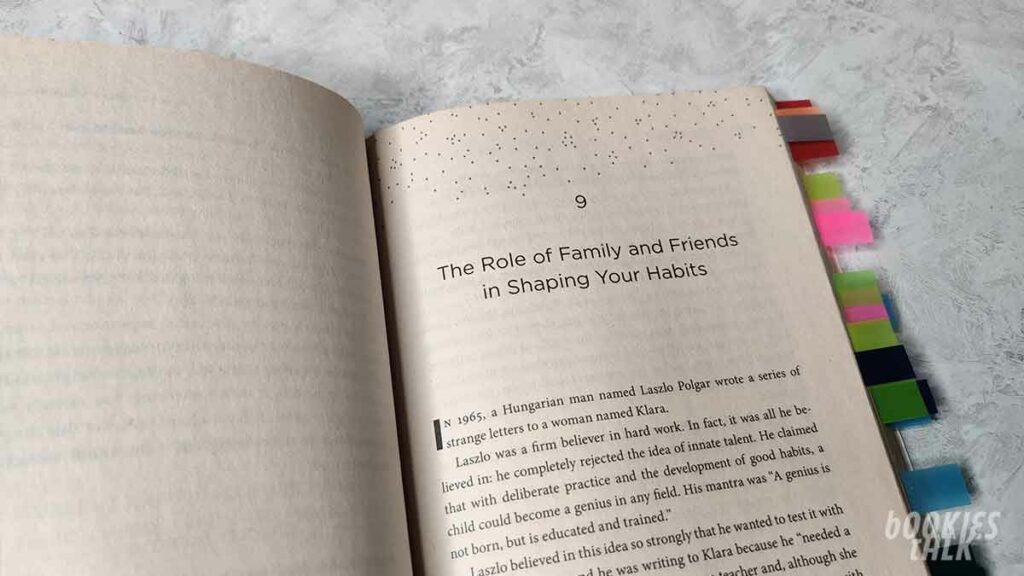
- As Charles Darwin noted. “In the long history of humankind, those who learned to collaborate and improvise most effectively have prevailed.” As a result, one of the deepest human desires is to belong. And this ancient preference exerts a powerful influence on our modern behavior
- One groundbreaking study tracked twelve thousand people for thirty-two years and found that “a person’s chances of becoming obese increased by 57 percent if he or she had a friend who became obese.” It works the other way, too. Another study found that if one person in a relationship lost weight, the other partner would also slim down about one-third of the time. Our friends and family provide a sort of invisible peer pressure that pulls us in their direction.
- This is one reason we care so much about the habits of highly effective people. We try to copy the behavior of successful people because we desire success ourselves. Many of our daily habits are imitations of people we admire. You replicate the marketing strategies of the most successful firms in your industry
Chapter No. 10: How to Find and Fix the Causes of Your Bad Habits

- Your brain did not evolve with a desire to smoke cigarettes or to check Instagram or to play video games. At a deep level, you simply want to reduce uncertainty and relieve anxiety, to win social acceptance and approval, or to achieve status.
- Two people can look at the same cigarette, and one feels the urge to smoke while the other is repulsed by the smell.
- When you binge-eat or light up or browse social media, what you really want is not a potato chip or a cigarette or a bunch of likes. What you really want is to feel different.
- The key to finding and fixing the causes of your bad habits is to re-frame the associations you have about them. It’s not easy, but if you can reprogram your predictions, you can transform a hard habit into an attractive one.
Chapter No. 11: Walk Slowly, but Never Backward
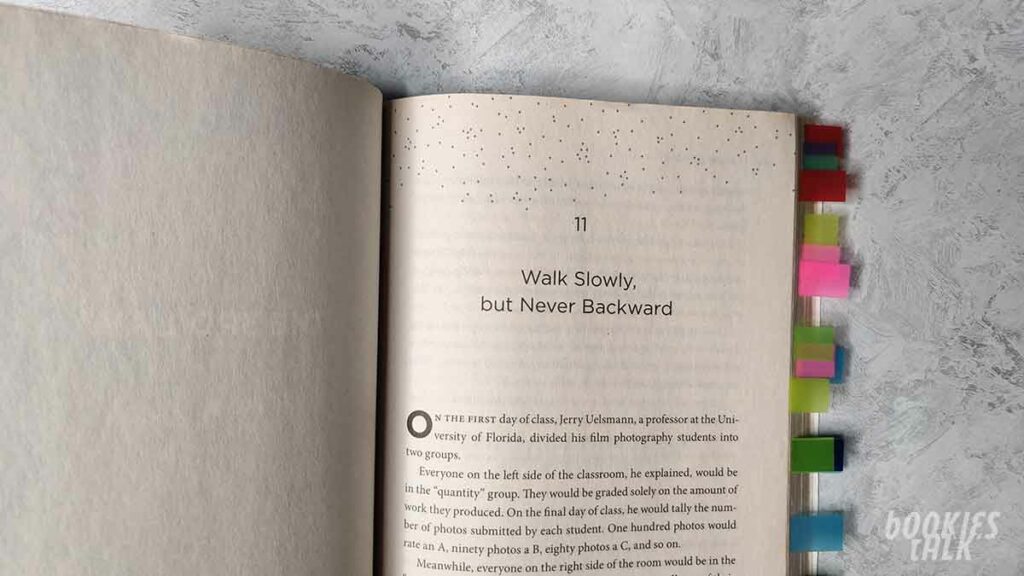
- If I outline twenty ideas for articles I want to write, that’s motion. If I actually sit down and write an article, that’s action. If I search for a better diet plan and read a few books on the topic, that’s motion. If I actually eat a healthy meal, that’s action.
- Motion makes you feel like you’re getting things done. But really. you’re just preparing to get something done. When preparation becomes a form of procrastination, you need to change something. You don’t want to merely be planning. You want to be practicing.
- First described by neuropsychologist Donald Hebb in 1949, this phenomenon is commonly known as Hobbs Law: “Neurons that fire together wire together.”
- In 1860, the English philosopher George H. Lewes noted, “In learning to speak a new language, to play on a musical instrument, or to perform unaccustomed movements, great difficulty is felt because the channels through which each sensation has to pass have not become established: but no sooner has frequent repetition cut a pathway than this difficulty vanishes; the actions become so automatic that they can be per- formed while the mind is otherwise engaged.” Both common sense and scientific evidence agree: that repetition is a form of change.
- In practice, it doesn’t really matter how long it takes for a habit to become automatic. What matters is that you take the actions you need to take to make progress. Whether an action is fully automatic is of less importance.
Chapter No. 12: The Law of Least Effort
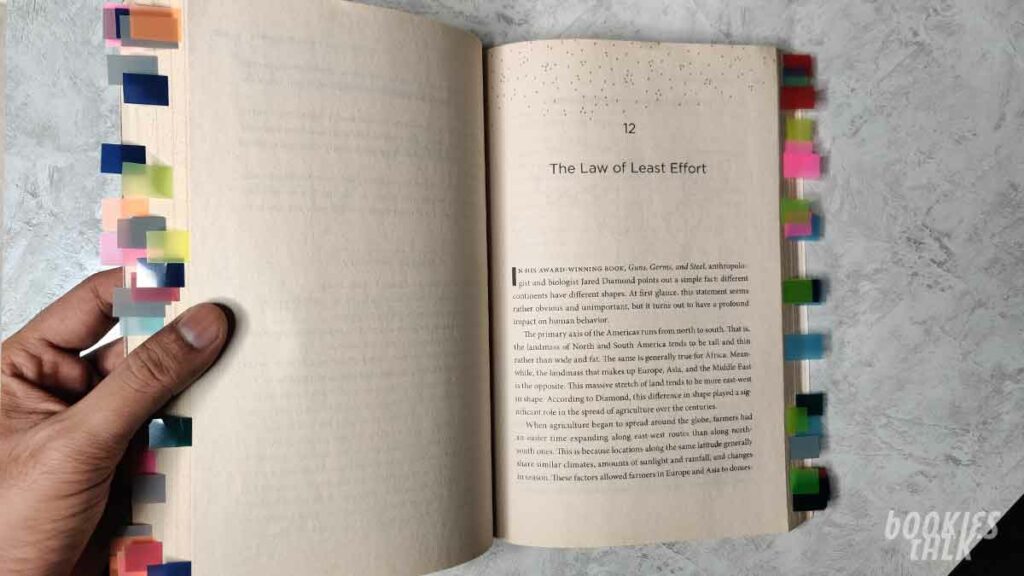
- If you can make your good habits more convenient, you’ll be more likely to follow through on them.
- There are many ways to prime your environment so it’s ready for immediate use. If you want to cook a healthy breakfast, place the skill- let on the stove, set the cooking spray on the counter, and lay out any plates and utensils you’ll need the night before. When you wake up making breakfast will be easy.
- Whether we are approaching behavior change as an individual, a parent, a coach, or a leader, we should ask ourselves the same question: “How can we design a world where it’s easy to do what’s right?” Redesign your life so the actions that matter most are also the actions that are easiest to do.
Chapter No. 13: How to Stop Procrastinating by Using the Two-Minute Rule
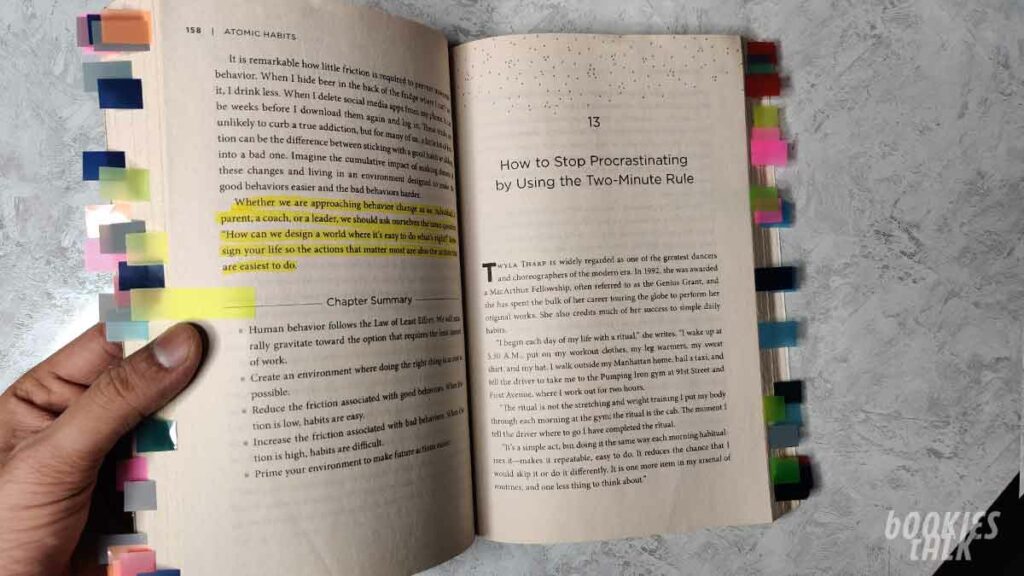
- You sit through a bad movie for two hours. You keep snacking even when you’re already full. You check your phone for “just a second” and soon you have spent twenty minutes staring at the screen. In this way, the habits you follow without thinking often determine the choices you make when you are thinking.
- When you start a new habit, it should take less than two minutes to do. You’ll find that nearly any habit can be scaled down into a two-minute version:
- (1) “Read before bed each night” becomes “Read one page.”
- (2) “Read before bed each night” becomes “Read one page.”
- (3) “Do thirty minutes of yoga” becomes “Take out my yoga mat.”
- (4) “Study for class” becomes “Open my notes.”
- (5) “Fold the laundry” becomes “Fold one pair of socks.”
- (6) “Run three miles” becomes “Tie my running shoes.”
- The actions that follow can be challenging, but the first two minutes should be easy. What you want is a “gateway habit” that naturally leads you down a more productive path.
- If the Two-Minute Rule feels forced, try this: do it for two minutes and then stop. Go for a run, but you must stop after two minutes. Start meditating, but you must stop after two minutes. Study Arabic, but you must stop after two minutes. It’s not a strategy for starting, it’s the whole thing. Your habit can only last one hundred and twenty seconds.
- We rarely think about change this way because everyone is confused by the end goal. But one push-up is better than not exercising. One minute of guitar practice is better than none at all. One minute of reading is better than never picking up a book. It’s better to do less than you hoped than to do nothing at all.
Chapter No. 14: How to Make Good Habits Inevitable and Bad Habits Impossible
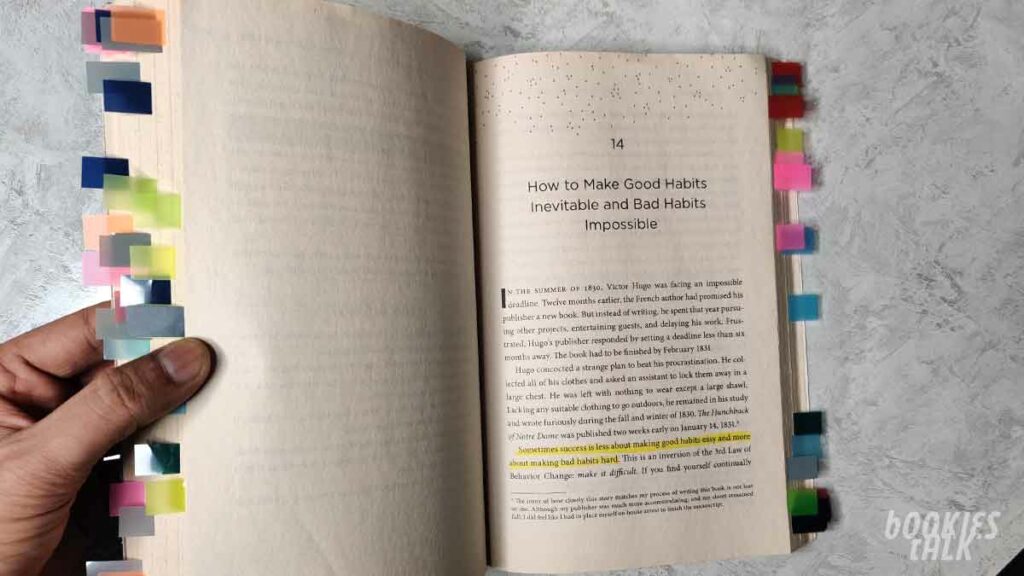
- Sometimes success is less about making good habits easy and more about making bad habits hard.
- I often find myself gravitating toward social media during any downtime. If I feel bored for just a fraction of a second, I reach for my phone. It’s easy to write off these minor distractions as “just taking a break,” but over time they can accumulate into a serious issue.
- As mathematician and philosopher Alfred North Whitehead wrote, “Civilization advances by extending the number of operations we can perform without thinking about them.”
Chapter No. 15: The Cardinal Rule of Behavior Change
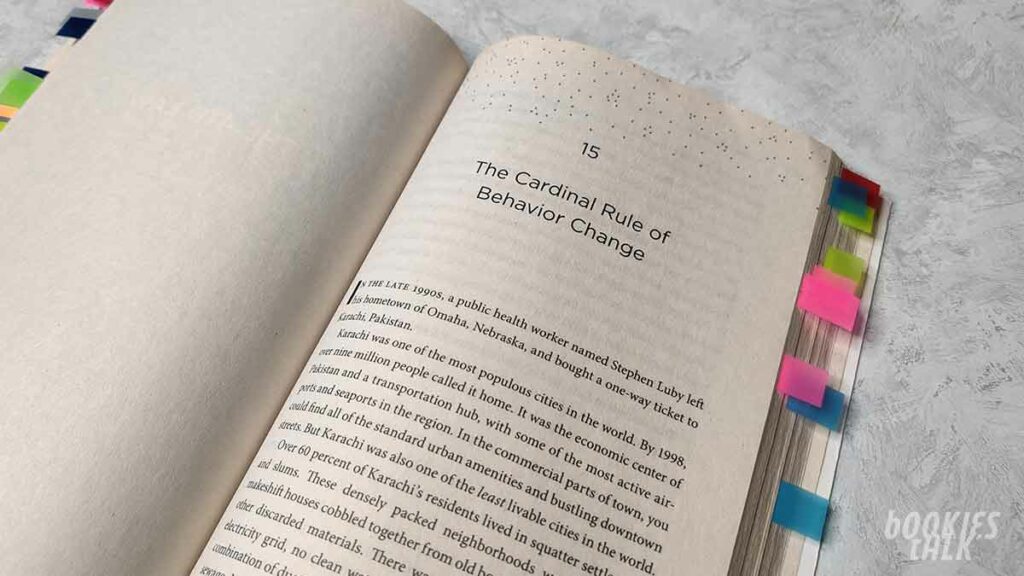
- But there is a trick. We are not looking for just any type of satisfaction. We are looking for immediate satisfaction.
- In the last one hundred years, we have seen the rise of the car, the airplane, the television, the personal computer, the internet, the smartphone, and Beyonce. The world has changed much in recent years, but human nature has changed little.
- Why would someone smoke if they know it increases the risk of lung cancer? Why would someone overeat when they know it increases their risk of obesity? Why would someone have unsafe sex if they know it can result in sexually transmitted disease? Once you understand how the brain prioritizes rewards, the answers become clear: the consequences of bad habits are delayed while the rewards are immediate. Smoking might kill you in ten years, but it reduces stress and eases your nicotine cravings now. Overeating is harmful in the long run but appetizing in the moment. Sex-safe or not-provides pleasure right away. Disease and infection won’t show up for days or weeks. even years.
- Put another way, the costs of your good habits are in the present. The costs of your bad habits are in the future.
- What is immediately rewarded is repeated. What is immediately punished is avoided.
- In summary, a habit needs to be enjoyable for it to last. Simple bits of reinforcement–like soap that smells great or toothpaste that has a refreshing mint flavor or seeing $50 hit your savings account-can of fer the immediate pleasure you need to enjoy a habit. And change is easy when it is enjoyable
Chapter No. 16: How to Stick with Good Habits Every Day
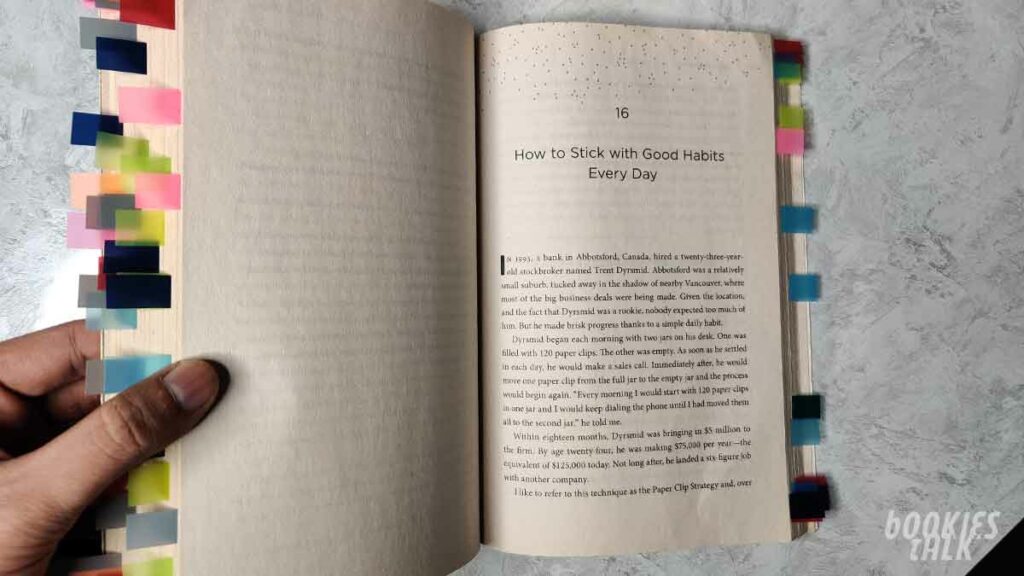
- Making progress is satisfying, and visual measures like moving paper clips or hairpins, or marbles provide clear evidence of your progress.
- Habit tracking is powerful because it leverages multiple Laws of Behavior Change. It simultaneously makes a behavior obvious, attractive, and satisfying.
- In summary, habit tracking (1) creates a visual cue that can remind you to act, (2) is inherently motivating because you see the progress you are making and don’t want to lose it, and (3) feels satisfying whenever you record another successful instance of your habit.
- Missing once is an accident. Missing twice is the start of a new habit.
- Too often, we fall into an all-or-nothing cycle with our habits. The problem is not slipping up; the problem is thinking that if you can’t do something perfectly, then you shouldn’t do it at all.
- As Charlie Munger says, “The first rule of compounding never interrupts it unnecessarily.”
- Furthermore, it’s not always about what happens during the workout. It’s about being the type of person who doesn’t miss workouts. It’s easy to train when you feel good, but it’s crucial to show up when you don’t feel like it even if you do less than you hope. Going to the gym for five minutes may not improve your performance, but it reaffirms your identity.
- We care more about getting ten thousand steps than we do about being healthy.
Chapter No. 17: How an Accountability Partner Can Change Everything
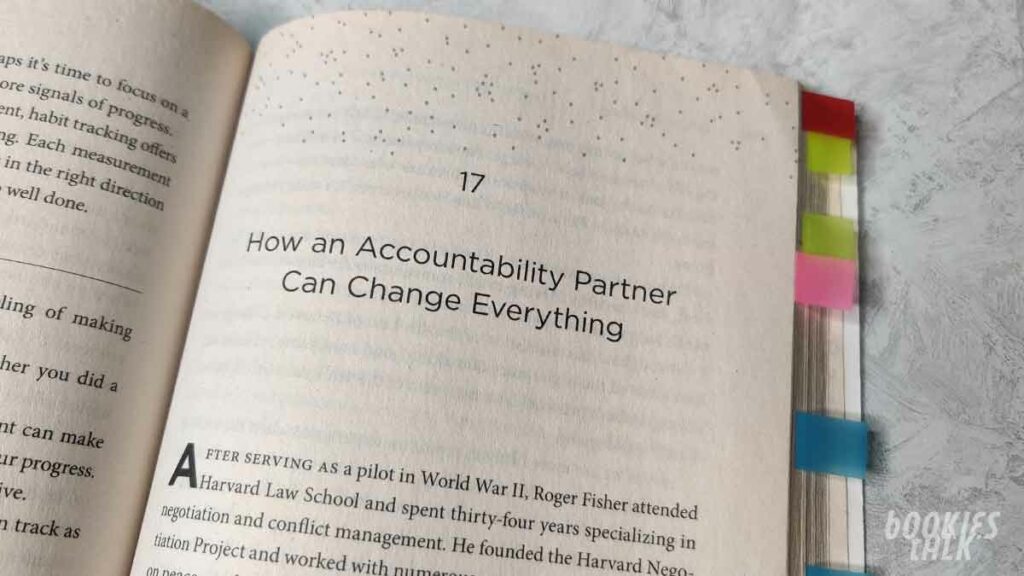
- If a failure is painful, it gets fixed. If a failure is relatively painless, it gets ignored.
- The more immediate the pain, the less likely the behavior.
- To be productive, the cost of procrastination must be greater than the cost of action. To be healthy, the cost of laziness must be greater than the cost of exercise.
- To make bad habits unsatisfying, your best option is to make them painful in the moment. Creating a habit contract is a straightforward way to do exactly that.
- Knowing that someone is watching can be a powerful motivator. You are less likely to procrastinate or give up because there is an immediate cost. If you don’t follow through, perhaps they’ll see you as untrustworthy or lazy. Suddenly, you are not only failing to uphold your promises to yourself but also failing to uphold your promises to others.
Chapter No. 18: The Truth About Talent

- The secret to maximizing your odds of success is to choose the right field of competition. This is just as true with habit change as it is with sports and business
- All five characteristics have biological underpinnings. Extrovert sion, for instance, can be tracked from birth. If scientists play a loud noise in the nursing ward, some babies turn toward it while others turn away. When the researchers tracked these children through life, they found that the babies who turned toward the noise were more likely to grow up to be extroverts. Those who turned away were more likely to become introverts.
- You don’t have to build the habits everyone tells you to build. Choose the habit that best suits you, not the one that is most popular.
- Pick the right habit and progress is easy. Pick the wrong habit and life is a struggle.
- If you can’t find a game where the odds are stacked in your favor, create one. Scott Adams, the cartoonist behind Dilbert, says, “Everyone has at least a few areas in which they could be in the top 25% with some effort. In my case, I can draw better than most people, but I’m hardly an artist. And I’m not any funnier than the average standup. A comedian who never makes it big, but I’m funnier than most people. The magic is that few people can draw well and write jokes. It’s the combination of the two that makes what I do so rare. And when you add in my business background, suddenly I had a topic that few cartoonists could hope to understand without living it.”
- In summary, one of the best ways to ensure your habits remain satisfying over the long- run is to pick behaviors that align with your personality and skills. Work hard on the things that come easy.
Chapter No. 19: The Goldilocks Rule: How to Stay Motivated in Life and Work
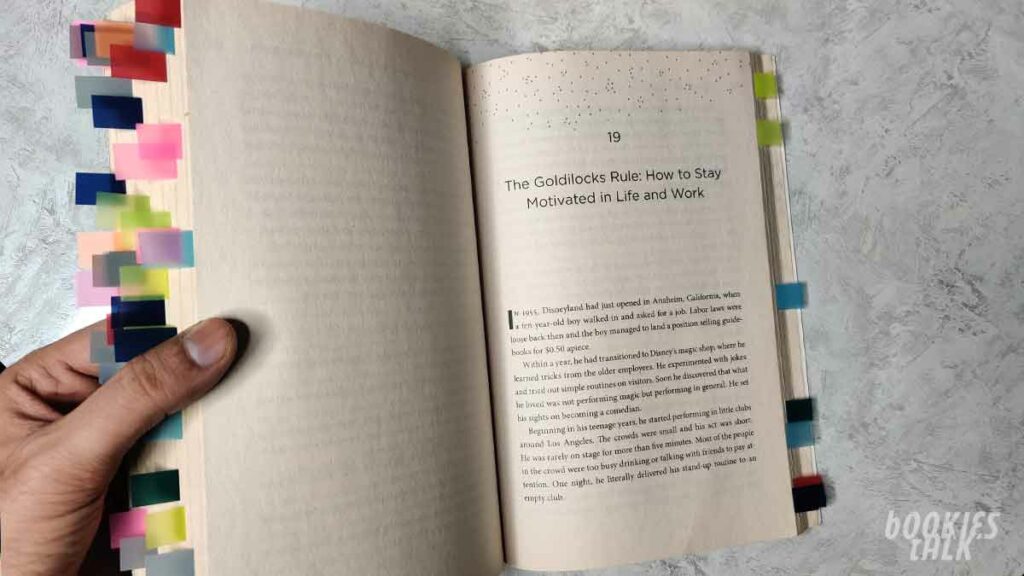
- The human brain loves a challenge, but only if it is within an optimal zone of difficulty. If you love tennis and try to play a serious match against a four-year-old, you will quickly become bored. It’s too easy. You’ll win every point. In contrast, if you play a professional tennis player like Roger Federer or Serena Williams, you will quickly lose motivation because the match is too difficult.
- The Goldilocks Rule states that humans experience peak motivation when working on tasks that are right on the edge of their current abilities. Not too hard. Not too easy. Just right.
- At some point it comes down to who can handle the boredom of training every day, doing the same lifts over and over and over
- The greatest threat to success is not failure but boredom. We get bored with habits because they stop delighting us. The outcome becomes expected
- As Machiavelli noted, “Men desire novelty to such an extent that those who are doing well wish for a change as much as those who are doing badly.”
- The sweet spot of desire occurs at a 50/50 split between success and failure. Half of the time you get what you want. Half of the time you don’t. You need just enough “winning” to experience satisfaction and just enough “wanting” to experience desire. This is one of the benefits of following the Goldilocks Rule. If you’re already interested in a habit, working on challenges of just manageable difficulty is a good way to keep things interesting
Chapter No. 20: The Downside of Creating Good Habits
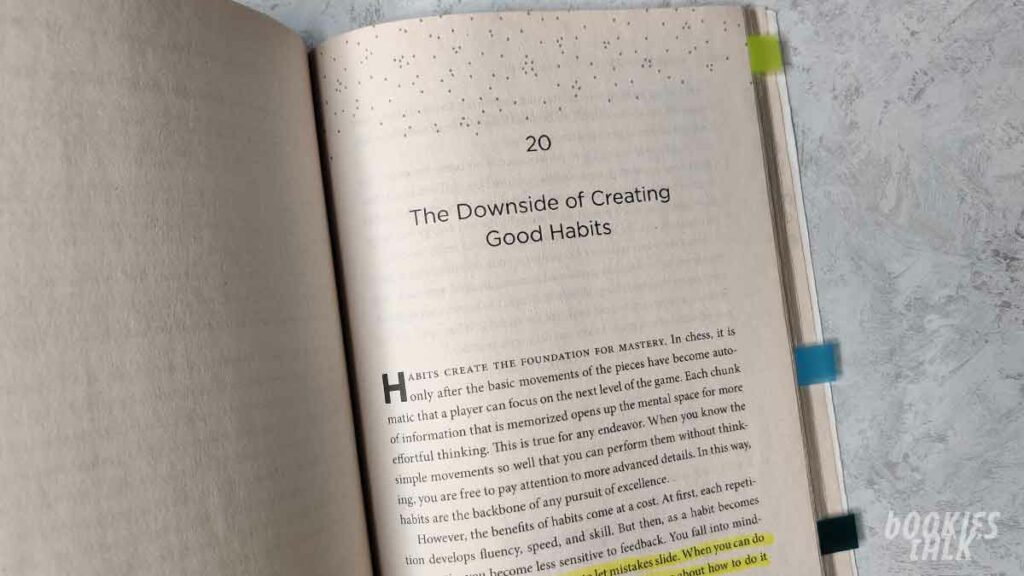
- It becomes easier to let mistakes slide. When you can do it “good enough” on autopilot, you stop thinking about how to do it better. The upside of habits is that we can do things without thinking. The downside of habits is that you get used to doing things a certain way and stop paying attention to little errors
- In fact, some research has shown that once a skill has been mastered there is usually a slight decline in performance over time.
- Improvement is not just about learning habits, it’s also about fine-tuning them. Reflection and review ensure that you spend your time on the right things and make course corrections whenever necessary like Pat Riley adjusting the effort of his players on a nightly basis. You don’t want to keep practicing a habit if it becomes ineffective.
- Reflection can also bring a sense of perspective. Daily habits are powerful because of how they compound, but worrying too much about every daily choice is like looking at yourself in the mirror from an inch away.
- A lack of self-awareness is poisonous. Reflection and review is the antidote.
- The following quote from the Tao Te Ching encapsulates the ideas perfectly:
- Men are born soft and supple; dead, they are stiff and hard. Plants are born tender and pliant: dead, they are brittle and dry. Thus whoever is stiff and inflexible is a disciple of death. Whoever is soft and yielding is a disciple of life. The hard and stiff will be broken. The soft and supple will prevail. – LAO TZU
Conclusion
These are all the notes from the book itself, so if you have read the Atomic Habits then you can re-read all of these notes every year and you will be able to recall the whole book.
So if you ever feel that you’re stuck somewhere or you’re back with old habits then read all of these notes and you will be able to bounce back.
This book has changed my life and I hope it will do the same for you. Also, one more thing, after reading the book, take action and don’t move to another book.
Buy Atomic Habits:
Happy reading…
Love What You Read, You Might Like These too…
By the way, we also have a WhatsApp Channel! If you love reading, this is the perfect place for you to join—and the best part? It’s completely FREE!

